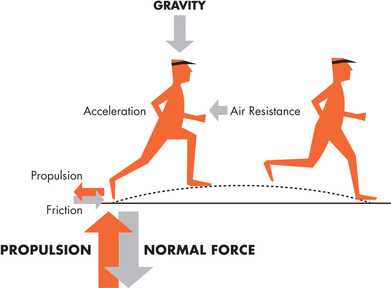Before taking PHYS 111, I had never thought that the force of friction would be the forward force allowing us to move forward when we walk and run. Instinctually around this time of the year, one would dive deeper into the topic of force of friction by asking: "Would it be easier to run on land or ice?". Logically, we would slip when running on ice. This happens when we push back for a step because the force we apply works in the opposite direction. For our purposes, the interaction of ice and the soles of our shoe is non-slipping.

Figure 1: Image of forces in effect while runninghttps://forces-in-running.weebly.com/how-do-forces-affect-running.html
To focus on the variables and components of friction we use:
uFn= Ffr
Since normal force, when running on flat land, is equal to our mass times the gravity constant (mg), we can see that the Fn is a constant when running on flat land. This would allow u, the coefficient of friction, to be the deciding factor as to whether or not a person is moving faster with the same amount of applied force in the opposite direction (Fapp). The kinetic friction of concrete is 0.8, according to https://hypertextbook.com/facts/2006/MatthewMichaels.shtml. The kinetic friction of ice is around 0.4 according to hypertextbook.com. This would mean the Force of friction would be greater for a person theoretically applying the same amount of force when running on concrete than on ice. Thus, although it may seem that ice would allow us to run with less force if we weren't slipping all the time on it, concrete would still be the feasible choice for running.
No comments:
Post a Comment
Note: Only a member of this blog may post a comment.